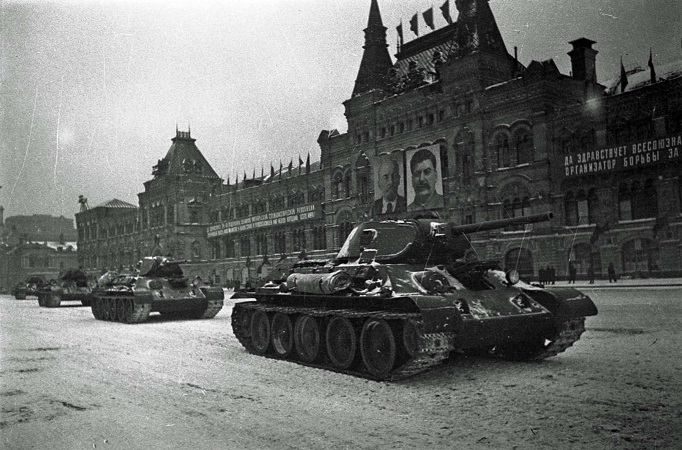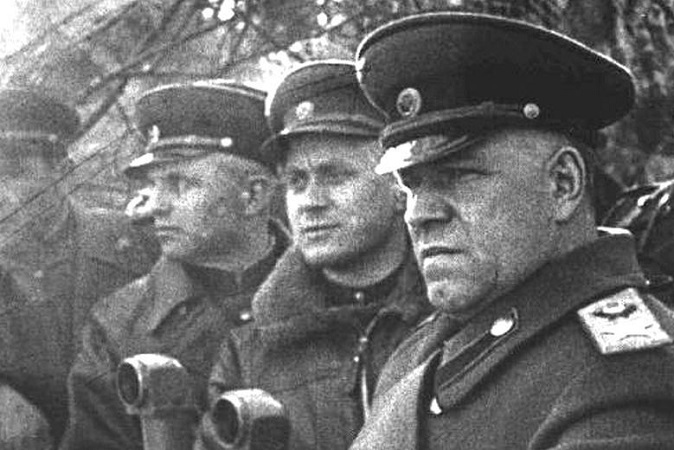● ● ●
At the
beginning of its involvement in World War II, the Red Army’s organization above the
level of the division was little different from that of
other European armies. Divisions and brigades were allotted
to rifle, mechanized, cavalry and airborne corps, which also
controlled a number of support units: medium artillery
regiments, antiaircraft artillery battalions, supply and
transportation battalions, medical assets, etc. The corps in
turn were assigned to field armies. Their strength was
variable, ranging from one corps and some additional
divisions to three corps. The average Army controlled three
corps with eight divisions.
In
peacetime the field armies came under the command of the
military districts into which the USSR was divided. For
instance the Western Special Military District,
headquartered in Minsk, controlled four field armies and an
additional four corps totaling 44 rifle, tank, mechanized
and cavalry divisions, plus three airborne brigades and a large
number of artillery, engineer and other support units. The
military districts also controlled the aviation and air
defense units stationed in their area of responsibility.
Upon the outbreak of war the front-line military districts
became operational commands called fronts (army groups):
Northwest Front, West Front, etc. They controlled the armies
stationed in their areas plus any additional forces allocated to
them from the Stavka (high command) strategic reserve.
This neat
and tidy scheme promptly fell apart when the Germans invaded
in 1941. The disasters that befell the Red Army in the first
months of the war showed that it lacked the leadership
cadres and technical specialists necessary to support its
Western-style organization. Though the USSR had made
significant progress in the area of education, the Red Army
was very large. Thus the educated, well-trained personnel that
it needed remained in short supply. And this problem was
much exacerbated by the military purge of the 1930s, which
had decimated the officer corps. Those purged were mostly
replaced by unqualified junior officers, abruptly promoted
to fill the vacancies created by Stalin’s distrustful
suspicions. Patriotic and brave these new men might be, but
the step up from command of a company or battalion to that
of a tank brigade or a rifle division was a long one. Given
time, at least some of these men might have grown into their new jobs—but on 22
June 1941, the clock ran out.

T-34 tanks on parade, Red
Square, Moscow, 7 November 1941 (Red Army Photo)
It
was a fortunate irony that some of the Red Army’s most
glaring deficiencies were exposed by the defeats it suffered
during the Winter War with
Finland (1939-40). By the time of the German
invasion certain reforms were already in progress—and under the spur
of grim wartime necessity, the reform process was accelerated. The
overall theme was simplification. Since the Army lacked
sufficient staff officers to make them effective, the rifle
corps were abolished. The
rifle divisions thus came under
the direct command of army headquarters. The mechanized
corps, tank divisions and mechanized divisions were
altogether abolished, being replaced by tank brigades
(really the size of a battalion), eventually grouped in
tank
corps
(really the size of a division). The
rifle divisions
were stripped of
most of their technically trained personnel, which were
allotted to large specialized units:
artillery brigades and divisions,
engineer brigades, etc.
The
infantry armies were thus reduced to the approximate
strength of a strong German corps. The number of rifle divisions
and rifle brigades assigned to them ranged from six to
eight, with perhaps a couple of tank brigades and artillery
brigades in addition—all of them chronically understrength.
The average configuration of an infantry army in mid-1942 is
shown below. If earmarked for a major
offensive, an army’s units would be brought up to authorized
strength, and the army itself would be reinforced with additional
units: artillery brigades, tank brigades,
self-propelled
artillery (armored
assault gun) regiments, engineer regiments and, once they
became available in sufficient numbers, tank corps.
To
supplement the infantry armies, a number of tank armies were
set up in late 1941. Initially they were formed with a
variable number of independent tank
brigades and battalions, rifle divisions, and rifle
brigades. The process of grouping the armored units into
division-sized tank corps was a slow one that stretched into
1942. By mid-1943, however, tank army organization was more
standardized, consisting entirely of mobile units: typically
two tank corps and a
mechanized corps,
plus a variable number of separate tank and SP artillery
brigades and regiments. Shown below is the
organization of the 1st Guards Tank Army in April 1945,
which was typical. The 1st GTA had around 600 tanks of
various types plus around 200 armored SP assault guns.
Also set up in late 1941 was the first of the so-called
shock armies. These were conceived as “breakthrough” formations, particularly strong in
artillery
and armor. The first ones, however, were little different from the
infantry armies except for being somewhat stronger in armor and
artillery, but by 1944 they reached the size and
configuration shown below. By then the
rifle corps had been reintroduced, albeit in a much simpler
form than hitherto. The rifle corps controlled few if any tank,
artillery or other combat units; they were purely tactical
headquarters. Non-divisional tank, artillery, self-propelled
artillery, antitank, antiaircraft and engineer units were
pooled at the army level and allocated to divisions as
required. The late-war shock army was almost equal
in size to a German, US or British field army and commanded
a most formidable array of armor and artillery. Its major
deficiency was typical of the Red Army: lack of flexibility.

Marshal of
the Soviet Union
Georgy Zhukov
(right) as commander of the 1st Byelorussian Front in April
1945 (World War Photos)
The
highest echelon of command in the field remained the front
(army group). A typical one in mid-1943 might control four
or five infantry armies and a tank army, plus numerous
separate brigades, regiments and battalions of various
types. Fronts were given geographical designations, e.g. 1st
Baltic Front, 2nd Ukrainian Front, etc. A front earmarked
for a major operation could control as many as ten armies
plus support units and reserves, the latter frequently
including a number of tank, mechanized and cavalry corps.
During the first half of the war fronts were about the size
of a German field army, but from late 1943 onward they grew
closer to the size of a German army group.
At the
army and front level, the Red Army came to be organized in
such a way as to minimize its systemic deficiencies,
maximize its strengths and successfully execute its painfully evolved
tactical/operational doctrine. And those practical,
pragmatic accommodations to reality furnished the key to
victory over a redoubtable opponent: the German Army.
● ● ●